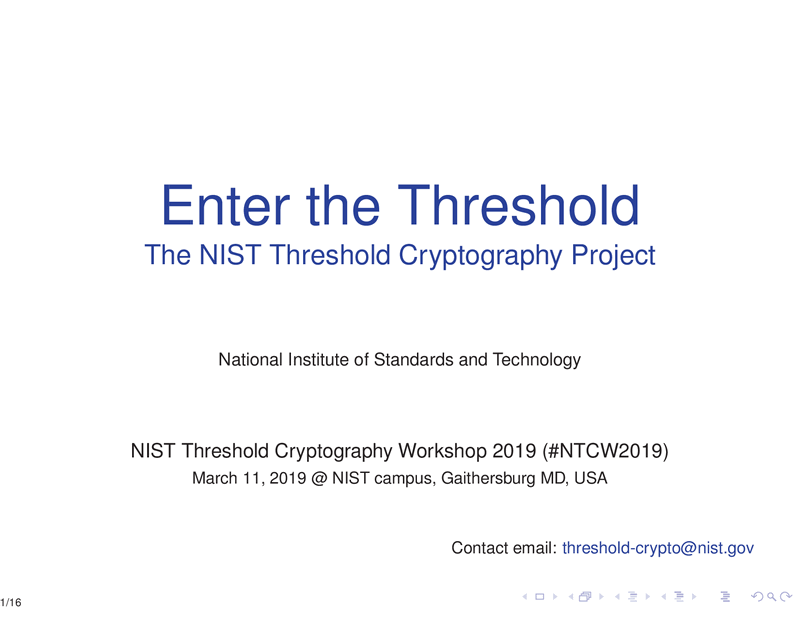Keynote 1 (Monday, March 11)
Speaker: Hugo Krawczyk (IBM Research, USA)
Title: Threshold Cryptography: Ready for Prime Time?
Abstract: The trend in trust decentralization together with the ever increasing value of digital assets (cryptocurrencies, blockchains, mega data repositories, key (mis)management, intellectual property, privacy, etc.) and the need to protect these assets for secrecy and availability, make threshold cryptography a most relevant technology whose time has come. We need to see more targeted applications as well as software platforms on which to build solutions that take into account real-world considerations such as asynchronous networks, support for diversified architectures, hardware enclaves, and more. Additionally, we need to refresh the set of techniques supporting threshold cryptography with advances in areas such as multi-party computation, quantum-resistant primitives, and blockchain-inspired consensus protocols. In addition to arguing these points, the talk will discuss some recent applications of threshold cryptography in the domain of key and password management, blockchain, and how threshold cryptography can be relevant to the #metoo movement.
Bio: Hugo Krawczyk is an IBM Fellow and Distinguished Research Staff Member with the Cryptography Group at the IBM T.J. Watson Research Center whose interests span theoretical and applied aspects of cryptography. He has contributed to the cryptographic design of numerous Internet standards, particularly IPsec, IKE, and SSL/TLS, and is a co-inventor of the HMAC message authentication algorithm. His most recent work in this area includes designs for TLS 1.3, the next generation TLS, and HKDF, the emerging standard for key derivation adopted by TLS 1.3, Signal, WhatsApp, Facebook Messenger and more. He has contributed to multiple areas of cryptography including to the theory and practice of key exchange, threshold and proactive cryptosystems, password authentication, and search on encrypted data. He is a Fellow of the International Association of Cryptologic Research (IACR) and the recipient of the 2015 RSA Conference Award for Excellence in the Field of Mathematics, the 2018 Levchin Prize for Contributions to Real-World Cryptography, and of multiple IBM awards, including two corporate awards.
Keynote 2 (Tuesday, March 12)
Speaker: Andrew Poelstra (Blockstream, USA)
Title: Challenges for Multisignature and Threshold Signature Implementation in a Bitcoin Context
Abstract: Bitcoin, started in 2009, is a digital currency in which all activity is publicly verifiable. Coins are controlled by spending policies expressed in Bitcoin Script, a simple stack-based programming language which supports hash preimage challenges and digital signatures. Included in Bitcoin Script is a basic form of threshold ECDSA signature: a list of public keys and a threshold is specified; the coins can then be moved if threshold-many valid ECDSA signatures are provided in sequence.
This threshold scheme is inefficient in terms of both signature size and verification time (both linear in the threshold size), which are the two most important considerations for cryptosystems designed for inclusion on blockchains. Being explicitly specified, they also represent a fungibility loss as threshold-controlled coins are visibly distinct from non-threshold-controlled coins. However, they achieve several practical goals which have proved difficult to preserve in more efficient threshold schemes: they are noninteractive; they require no persistent state during signing; they work in the plain public-key model and require no interactive key setup; their security follows immediately from the security of the underlying ECDSA scheme even when signing counterparties are considered to be adversarial.
In this talk we describe our work in developing a multisignature scheme for Bitcoin, called MuSig, which supports an extension to threshold signatures, over the last several years. We describe how consideration of both practical use cases and formal security models guided the evolution of our goals, and the unexpected tradeoffs that we found ourselves forced to make.
Bio: Andrew Poelstra is a Mathematician at Blockstream. He has dabbled in software development for the last twenty years, in open-source cryptography for ten. He became involved in Bitcoin in late 2011, and joined Blockstream cofounders Greg Maxwell and Pieter Wuille in developing the high-performance cryptography library libsecp256k1. His latest major project has been Mimble Wimble which is described as a blockchain design with no script support and blinded amounts. Like proverbial black holes, transaction outputs have no hair. This simplicity allows aggressive compaction and aggregation, resulting in a blockchain with much better scalability than any other design to date. He has a Bachelor of Science in Mathematics from Simon Fraser University. While completing his Masters of Arts at the University of Texas at Austin, he wrote and co-wrote several papers about Bitcoin, practical cryptography and mathematics.
 An unofficial archive of your favorite United States government website
An unofficial archive of your favorite United States government website


 ) and slide-decks of the presentations.
) and slide-decks of the presentations.























